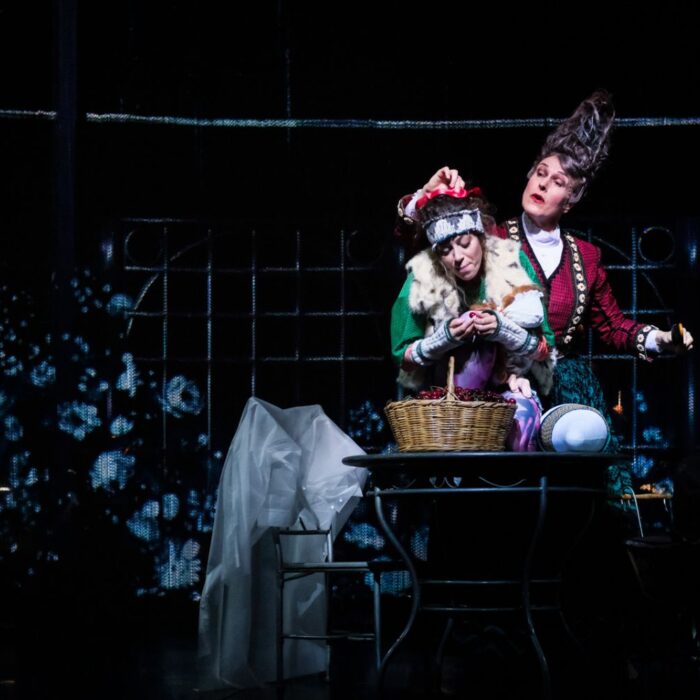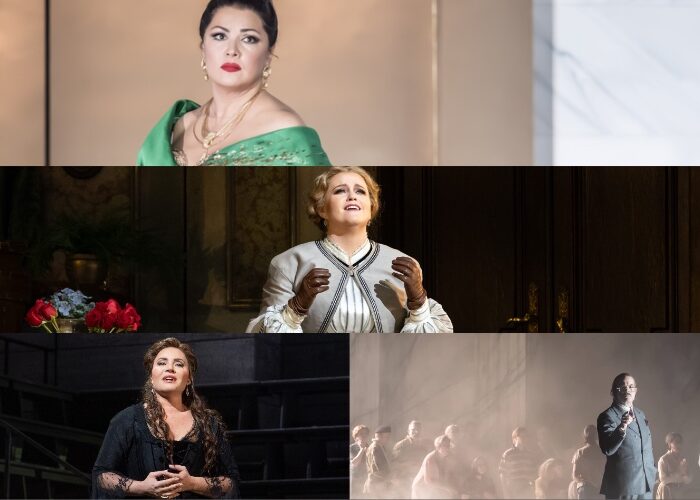
Opera Meets Film: The Question of Meaning in John Irvin’s ‘The Moon and the Stars’
By John VandevertJohn Irvin’s 2007 film “The Moon and the Stars” is a tale of arduous love, societal stigma, and unyielding dedication to art. The story revolves around the production of a cinematic rendition of Puccini’s fifth opera, “Tosca.” There are two primary narratives that play out in tandem: the arrest of the production’s director, Davide Rieti, a gay Jewish man played by Alfred Molina, by fascists, and the relationship between the soprano Kristina Baumgarten (played by Catherine McCormack) and baritone James Cavel (played by Jonathan Pryce).
What makes “Tosca” the best conceptual base for such a story? As with other films that use operas as the basis for their plot (“The Toll of the Sea,” 1922, “Tosca,” 1941), the opera’s narrative becomes a concept within the film that is used to tell several stories. We have previously examined how the Greek story of Orpheus and Eurydice (its operatic retellings being numerous and ranging from Gluck to Zhurbin) was used to tell another story of fated love. Other iconic operas, such as Offenbach’s “The Tales of Hoffmann” and Bizet’s “Carmen” have proved remarkable mediums for the telling of extremely relatable human stories.
Given Irvin’s noted fondness for varied cultural material, from literature (The Garden of Eden, 2008) and Biblical texts (The Fourth Angel, 2001), to Shakspearian plays (The Dogs of War, 1980), it is not strange to find opera among his source material. But why was this particular opera used, and what does it mean? In this month’s Opera Meets Film, we explore Irvin’s cinematic use of “Tosca.”
A Plot With Many Layers
Filmmaker Davide Rieti is creating a cinematic version of Puccini’s “Tosca” in an Italy teetering on the brink of fascism (circa 1922). German actress Kristina Baumgarten is hired to perform alongside English actor James Cavel, the latter being known for his abrasive personality. The two begin as argumentative colleagues before discovering their love for one-another. As filming progresses, the brewing Second World War looms ever larger and its authoritarian forerunners encroach upon the production. Happily, however, all is completed in the end and the couple’s love is affirmed.
The sexuality and religion of Rieti matters as to why “Tosca” was chosen to be the opera that frames the entire story. They speak to the tension between love and faith and religious obligation and individual authenticity. Both conflicts are central to “Tosca” itself and especially its titular heroine. In the original 1887 story, “La Tosca” by Victorien Sardou, the heroine turns into a tragic figure who, having been mercilessly tricked, becomes inadvertently responsible for four deaths, including her own. Set in 1800, within the context of warring European powers, the beginnings of the Napoleonic era, and the death of the Roman Republic (1798-1799), Sardou’s play was an unambiguous discourse on the consequences of unchecked pursuits of power and the costs borne by others. Sardou’s stark Republican leanings and affinity for anti-clericalism, while significantly downplayed in Puccini’s version, can be inferred as a quasi-backdrop for Irvin’s film.
The film takes place in the early days of Fascist Italy under Benito Mussolini; a time when earlier strains of proto-fascism were gaining traction within public and political circles alike. The filming of “Tosca” occurs during this blossoming of a dangerous brand of post-Romantic nationalism and the increasing ritualization of power. But Italian Fascism did not arise within a vacuum, and those within the cinematic universe of “The Moon and the Stars” would have also felt the effects of the other movements and revolutions of thought that gripped the Italian identity in the aftermath of the First World War.
The revelation of class disparity had led to calls for social reform and many people, ideologies, and movements were becoming active. Something that Irvin’s characters would have known about to some degree, situated as they were within the artistic and intellectual circles of pre- and early-Fascist Italy, was the rise of the Italian Futurist movement, led by poet Filippo Marinetti. Motivated by a Socialist-oriented industrial program, Futurism was to platform the revolution that would lead to Italy’s rebirth through the emancipatory vehicle of art. In Marinetti’s own words, ‘Except in struggle, there is no more beauty. No work without an aggressive character can be a masterpiece.’ It is interesting to interpret Irvin’s film — and the film-within-a-film being made by our protagonist Rieti — from this perspective: one contemporary to the period Irvin brings to the screen.
In pre- and early-Fascist Italy revolutionary ideals concerning the emancipatory potential of art were circulating within nearly every level of intellectual and artistic life. If we are to step into the shoes of Irvin’s film and understand the meaning of “Tosca” as it is portrayed here, we must comprehend what Puccini’s opera meant to interwar Italy, and the significance of Rieti making such a film concurrent with the birth of Italian Fascism. On top of this artistic consideration is the human one: the experience of Rieti as a gay Jewish filmmaker in an increasingly fascist state. As radical as the artistic ideals that gripped Europe were, the lived reality for many of its inhabitants was increasingly one of danger and fear.
The Puccini/Tosca Connection
If we are to problematize “Tosca” within Fascist Italy, a question immediately comes to mind: what did Mussolini think of opera? Mussolini was known to patronize theatres and opera houses. Often, however, he would become the evening’s focal point — something that Mussolini was reported to have found tiresome. Regulations against foreign operatic repertoire noticeably expanded in the 1930s. Performances of French and English works were significantly curtailed while patriotic themes were prioritized. The stage for theater and opera alike became the pulpit for the cultivation of a drive for a unified national — and nationalist — consciousness. The performing arts were a vital tool for the dictatorship’s control over the masses. This was a fact well known at the time — in 1922 Arturo Toscanini, who had been previously championed by Mussolini, signalled his resistance to the regime by refusing to conduct “Giovinezza,” the official hymn for the Italian Fascist Party. When he again refused in 1933 he was forced to emigrate.
It is an open secret that the fondness between Mussolini and Puccini was reciprocal. In 1922 Puccini stated his belief that Mussolini was ‘undoubtedly sent by God for the salvation of Italy.’ Mussolini became dictator in 1922 and opera thrived under him. The weight of Puccini’s creative legacy was immense and served as a tool in the arsenal of the dictator’s cultural weapons. The plot thickens, of course, when one considers “Tosca,” which depicts the decline of Italian monarchical rule and rather unambiguously rejects the archetype of the Romantic hero. As Alexander Wilson notes, themes rife in turn-of-the-century French literature such as ‘sadism, wanton violence, depraved sexuality, murderous women, artificiality, gratuitous sensation,’ are all themes central to “Tosca.” This must have somewhat frustrated Puccini’s desire to lead Italian music towards a new, demonstratively nationalistic revitalization. One of the opera’s biggest issues was the lack of a clear distinction between good and evil, protagonist and antagonist, victim and aggressor. In “Tosca” morals, ethics, and virtues collide in caustic ways, making it impossible to describe any character as solely good or bad.
“Tosca” premiered in 1900. Turn-of-the-century Italy was culturally defined by nationalist desires for the hero, as seen in the quasi-deification of Verdi among other visionaries such as poet Giosuè Carducci — this search for the hero would only be amplified under fascism in the following interwar years. Italian unification had only recently concluded in the fall of 1870 — the same year that Bonaparte’s Second French Empire was scrapped for a Republican alternative — and Italy needed galvanizing figures more than ever. “Tosca” was a controversial work within this milieu. Musically it was Italian, yet it failed to narratively posit what the Italian people thought Italy ought to be.
To travel forwards in time two decades to the Italy of the early 1920s and Puccini, though he was still favoured and despite the fortitude, courageousness, and perseverance that circulated through nearly all his operatic characters, was perceived to write ‘feminine’ operas: this was diametrically opposed to the masculinity sought by fascist ideology, feeding upon the nationalist desires of the turn-of-the-century. As Mosco Carner wrote regarding Puccini, there was a ‘splintered, neurotic personality, feminine in many ways and rooted in man’s strongest biological urge — sexuality.’ While Verdi’s operas were a ‘battle cry,’ Puccini’s operas were a ‘mating call.’ Carner’s obvious bias aside, he makes explicit the complexities of Puccini’s operatic heroines. In the context of pre- and early-Fascist Italy, Puccini’s feelings of loss for the once shining future of Italy may have led him into the arms of Mussolini, seeing in Mussolini only what he hoped he could be for Italy — but in Puccini’s operas, such a man as Mussolini could never be the hero. Puccini’s protagonists were too complex for the simple chauvinism of fascism.
_________
This interpretation of Irvin’s film through the lens of the period in which it is set leaves many mysteries for the audience to unravel. The symbolism of “Tosca,” as discussed here, would have been an anathema for the cultural context of the period in which the film takes place — but maybe that is the point. The sexuality and religion of the filmmaker Davide Rieti must be remembered: in Fascist Italy, these would have caused problems to say the very least. Outwardly, to produce a film based upon an opera by the then-living composer Puccini, a favourite of the operatic patron and fascist luminary Mussolini, is an act of pure nationalism. But the hidden, countercultural depths of “Tosca” do not reflect the fascist ideals of the period, just as being both gay and Jewish makes Rieti incompatible with the homophobic and antisemitic rhetoric of the fascists. The opera Rieti chooses to stage is a reflection of himself as a filmmaker and a human begin. On the surface he toes the ‘party line,’ but in reality runs counter to its hateful ideology, travelling in the direction of liberation and emancipation through art.
Ultimately, the choice of “Tosca” in Irvin’s film opens up a host of questions concerning what it could have meant for the characters in their cinematic world and what Irvin was trying to imply through its use. But, just like “Tosca” upon its premiere in 1900, what it means is what we want it to mean, what we desire to see reflected back to us, and what our world influences us to perceive in it.


